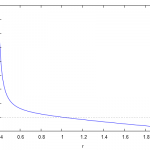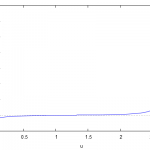Very interesting integrands.
Date: Fri, Mar 16, 2018 at 9:49 AM
Subject: Re: Fwd: note 403(6)
To: Myron Evans <myronevans123>
The integral of delta phi with exponent 3/2 is not analytically integrable according to Maxima. I have plottet the integrands I(u) and I(phi), see attachments. Both have a pole, we will see if we have to integrate up to this value for realistic orbital parameters.
Horst
Am 16.03.2018 um 09:41 schrieb Myron Evans:
Many thanks again, I plan to use this note as the main part of UFT403, Sections 1 and 2. Your check is very interesting, and I will include it in the final paper.. I will rework Note 403(7) it is probably power 3/2 in the denominator, a minor error of hand calculation. Use of the computer to mend these errors is obviously of key importance. Maxima may have an analytical or numerical solution for the correction function delta phi, giving the complete orbit phi + delta phi as well as the precession of the perihelion for orbits of small eccentricity from Note 403(6). Einstein’s famous or infamous result for the precession of the perihelion did not attempt to give the orbit. The major advance in knowledge is that precession is due to vacuum fluctuations.
Subject: note 403(6)
To: Myron Evans <myronevans123>The Schwarzschild radius is 3*10^3 m, not 3*10^5 m, a small typo.
In eq. (34) there is a sign typo but it has been corrected in (35).A check for the correctness of the result (37) is as follows:
assume
omega = a/r
as in previous papers. Then eq.(37) givespsi = pi (1+a).
For a small a, a<<1, we have psi ~ pi which is the result for vanishing precession.
Horst
- int dphir
- int dphiu

